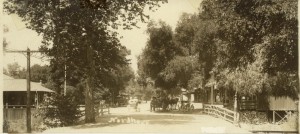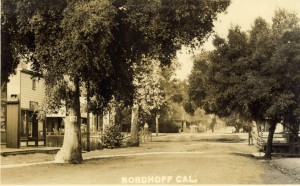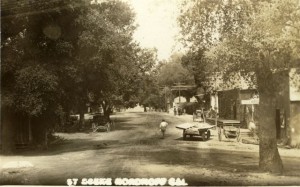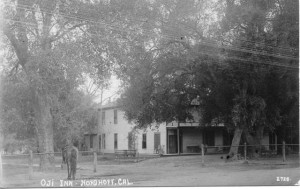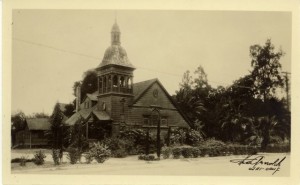This article first appeared in the August 26, 1970 edition of the Ojai Valley News. It is reprinted here with their permission. The author is Ed Wenig.
Ojai was ‘torn apart and rebuilt’
(Editor’s note: this is the second in a series of articles by historian Ed Wenig on Civic Center Park and the man responsible for its gift “to the people of the Ojai Valley” — Edward Libbey).
On September 1, 1916, THE OJAI printed an editorial from the Ventura Free Press, written by Editor D. J. Reese, who had attended the Men’s League Banquet in March at the Foothills Hotel:
“Some morning, not far distant, the village of Nordhoff is going to wake up and find itself famous. The work being done in that section just now would make the man who has known Nordhoff of old rub his eyes in astonishment if he was brought into the place suddenly. Great things are in store no doubt. The town has been torn apart and several sections have been removed hither and yon. There has been a general clearing up of everything, and everybody has an expectant look as though wondering what will happen next. The main street has been piled full of terra cotta brick, and no one seems to know what is doing. Old landmarks like the Clark stables and the Ojai Inn have vanished as before a Kansas cyclone. Only the beautiful oaks, and here and there a substantial house like the bank or the clubhouse or the Nordhoff fountain and splendid Ojai atmosphere seem to be left. Something is surely doing. Ask what it is and the Nordhoffite will throw up his hands and mention the name of Libbey. You hear about Libbey every time you ask a question. Everywhere you go you note that somebody is working hard at something or other in digging ditches or burying water pipe or clearing underbrush or building massive and magnificent cobble walls. Why, it is to be another Montecito, you are told . . . “The people there are to be congratulated that they have a Libbey who has taken an interest in their affairs. It is to be hoped they will give him free rein.”
Vast Land Holdings
At an Ojai Valley Men’s League banquet at the Foothills Hotel J. J. Burke, speaking of improvements, told of a well of Mr. Libbey’s which “will pump at least 65 inches, and if Mr. Libbey’s plans materialize he will spend $20,000 in getting the water to his ranch. . . . The old Ojai Inn and all but one of the Berry Villa buildings have been torn down or moved away, making room for more extensive improvements in the future. Through the generosity of Mr. Libbey, Signal Street was cut through and graded to the railroad.”
In the spring of 1916 Libbey was reported to be visiting his friend, H. T. Sinclair and discussing with Mr. Thacher, Colonel Wilson and W. W. Bristol “sundry matters of importance to the community.”
On June 9, 1916 it was announced that E. D. Libbey had bought 200 more acres to add to his previous 300-acre property. “Among the early improvements will be the laying of a water main from his well on the Gally tract to his large holdings. And that is not all, as the entire square upon which once stood the Ojai Inn, is to be improved in a manner that augurs well for the future of Nordhoff, which is good news to the entire community. Mr. H. T. Sinclair has been taken into Mr. Libbey’s confidence and will be the directing head during his absence. Let us be glad, as well as thankful for so generous a promoter as E. D. Libbey.”
On June 16, 1916, we are told that Mr. Libbey has bought the last parcel of privately owned land in what is now the Civic Park. In the local paper, “The plans Mr. Libbey is making to benefit both the town and the Valley has met with the highest approbation of the committee and the cooperation of the League in every way is assured.”
It was reported on June 30 that the Berry Villa, “an historical step-sister of the Ojai Inn, now a demolished antiquity,” had been torn down and the lumber hauled away.
By July 14, fifty men in one crew were working on the Libbey pay roll. Tom Clark destroyed his barn north of his livery stable and constructed a rock wall for a modern garage. This wall can still be seen as part of the Village Drug Store.
Early in November, Architect Requa, of the San Diego architectural firm of Mead and Requa, went to Toledo and got full approval of the plans for the renovation of the main street of Nordhoff. The local newspaper reported, “The post office tower, penetrating the lower heavens 65 feet is to be a reality. There are many features that we shall be delighted to prattle about when fully assured that the architect has removed the censorship.”
In March, 1917, representatives of the Men’s League met with Mr. Libbey. A corporation was formed under the name of THE OJAI CIVIC ASSOCIATION. The incorporators were E. D. Libbey, S. D. Thacher, J. J. Burke, Harrison Wilson, H. T. Sinclair, A. A. Garland, and H. R. Cole. Said the editor of the paper: “The initial purpose of the corporation is to assume title to the valuable property acquired by gift from Mr. Libbey . . . This beautiful park and the tennis courts, covering more than seven acres, is to become the property of the people of Nordhoff and the Ojai Valley.
Concurrent with the changes in the appearance of the town of Nordhoff came a popular move to change the name of the village to Ojai. A petition was circulated under the auspices of Supervisor Tom Clark requesting the name change, and received so many signatures that it was five feet long by the time H. D. Morse, manager of the Foothills Hotel, sent it to Washington D. C. In March, 1917, Senator James D. Phelan sent the following telegram: “You may announce the change of name from Nordhoff to Ojai.”

